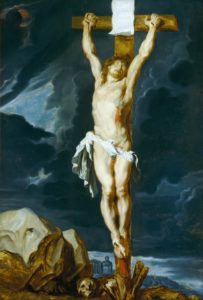Object of the Month: April 2020
Christ on the Cross
Oil on panel, c. 1610, branded on reverse with the seal of Antwerp Guild of St. Luke
Peter Paul Rubens
Flemish, 1577–1640
So they took Jesus, and He went out, bearing His own cross, to the place called The Place of the Skull, which in Aramaic is called Golgotha. There they crucified Him, and with Him two others, one on either side, and Jesus between them. John 19:17,18
Christ on the Cross is one of M&G’s better-known paintings, due in part to the great master who created it. Peter Paul Rubens was born in Seigen, Germany and reared Roman Catholic. At age 12, his family returned to Antwerp, where he received a classical education, typical of the influence of Renaissance Humanism. In the Netherlands, he more than likely apprenticed under the leading artists of the day including Tobias Verhaect, Adam van Noort, and Otto van Veen. By 1598, he obtained the status of a master painter and entered the Antwerp Guild of Saint Luke, similar to a union for artists.
To continue his training, he moved to Italy two years later, where exposure to masterworks by artists like da Vinci, Michelangelo, Titian, and Caravaggio further influenced his developing style. During his eight years on the peninsula, he completed commissions for nobility and churches in both Italy and Spain, spending much of his time serving the Duke of Mantua. By the time he returned to Antwerp in 1609 his renown as an artist preceded him. In his lifetime he filled hundreds of commissions, served as a court painter (in Italy and the Netherlands), diplomat, and ambassador.
As the head of a large studio, he employed as many as three hundred assistants to help him meet the commissions he received from European kings and aristocracy. His workshop included artists who specialized in certain parts of a painting’s composition such as animals, flowers, or physical features. Although, Rubens most likely often painted the hands, feet, or faces of individuals. One of his best-known students is Anthony van Dyck, also represented in M&G’s collection. Rubens’ pageant-like paintings represent the apex of the High Baroque style. He stands as one of the greatest, if not the greatest, baroque artists of the Golden Age.
According to several specialists, M&G’s painting is recognized as one of Ruben’s better works. Likely, this work was a modello or prototype that would be referenced by an assistant to copy and complete a larger, commissioned version, which may explain some of the unfinished elements such as the absence of the crown of thorns and writing above Christ’s head.
Additionally, some stylistic features are distinctive to this specific painting including the single cross instead of three and a nail for each appendage. However, Christ’s position with his arms spread upward instead of outward represents a turning point in Christian iconography. In an exhibition catalog, former North Carolina Curator David Steel, explains Rubens’ novel depiction: “Rubens’ Christ suffers heroically, his muscles tense, his fingers clenched, and his arms raised almost straight above his head, thrusting his torso outward. This image emphasizes the physical sacrifice which Christ suffered on behalf of mankind, yet his upward straining, restated in the staves below, suggests his ultimate triumph.”
Of the three crosses on Golgotha, Christ was in the middle, the place reserved for the most notorious of lawbreakers. Rubens presents Christ, the perfect Son of God, as the singular focus of punishment and suffering, which the Apostle Paul emphasizes in II Corinthians 5:21, “He hath made Him to be sin for us, who knew no sin; that we might be made the righteousness of God in Him.” Meditate and marvel at the wonder of God’s crucified and resurrected Son during this Easter season!
John Good, Security Manager and Docent
Published in 2020
